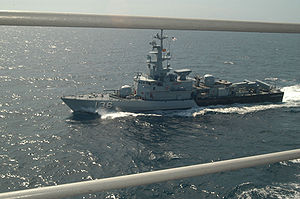
The Maestrale class is a class of frigates of the Italian Navy. The class is composed of eight vessels, all of which were built by Fincantieri S.p.A., Riva Trigoso, except for Grecale, which was built by Fincantieri S.p.A. – Muggiano, La Spezia.

The Soviet designation Project 1241 Molniya are a class of Russian missile corvettes. They have the NATO reporting name Tarantul. These ships were designed to replace the Project 205M Tsunami missile cutter.

The Royal Malaysian Navy is the naval arm of the Malaysian Armed Forces. RMN is the main agency responsible for the country's maritime surveillance and defense operations. RMN's area of operation consists of 603,210 square kilometers covering the country's coastal areas and Exclusive Economic Zones (EEZ). RMN also bears the responsibility of controlling the country's main Sea Lines of Communications (SLOC) such as the Straits of Malacca and the Straits of Singapore and also monitors national interests in areas with overlapping claims such as in Spratly.

The FREMM, which stands for "European multi-purpose frigate", is a Franco-Italian family of multi-purpose frigates designed by Naval Group and Fincantieri. In France, this surface combatant is known as the "Aquitaine class", while in Italy it is known as the "Bergamini class". The lead ship of the class, Aquitaine, was commissioned in November 2012 by the French Navy. Italy has ordered six general purpose and four anti-submarine variants. France, on the other hand, has ordered six anti-submarine variants and two air-defense ones.

ROCS Tian Dan is the eighth ship of the Cheng Kung-class guided-missile frigates of the Republic of China Navy (ROCN), which was based on the Oliver Hazard Perry class of the United States Navy. Tian Dan was intended to be the first hull of the second batch of the class, with improved armament and electronics. However, delays in the development of the weapon systems and electronics led to the second batch being cancelled. In 1999, the first ship of the second batch was re-ordered to the standard design with all the improvements to the design. The ship was constructed beginning in 2001 by the China Shipbuilding Corporation in Taiwan and the frigate was launched in 2002 and entered service with the ROCN in 2004. In 2014, Tian Dan was among the Taiwanese vessels sent to assist in the search for the missing Malaysia Airlines MH370 flight.
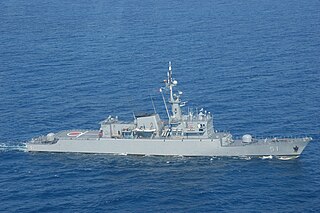
The Almirante Padilla-class frigates is a series of frigates operated by the Colombian Navy. The designation of this class is Type FS 1500 and there are four ships in service. The ships were built by Howaldtswerke-Deutsche Werft (HDW) at Kiel, West Germany in the 1980s, with the first vessel commissioning in 1983 and the last in 1984. The frigates have undergone significant modification over their careers with the 2012 Orion Program Upgrade significantly modernising the vessels. Two similar ships operate as the Kasturi-class corvettes in the Royal Malaysian Navy.

The Kasturi-class corvettes are two ships of the Royal Malaysian Navy, KD Kasturi and KD Lekir. They were acquired in the mid-1980s. The two ships constitute the Malaysian Navy's 22nd Corvette Squadron, their homeport being Lumut. After about 25 years of service, they underwent an extensive modernisation known as Service Life Extension Program (SLEP) starting in 2009, enabling them to be employed for another 10 to 15 years. They have since been returned to active duty.

The Otomat is an anti-ship and coastal defence missile developed by the Italian company Oto Melara jointly with Matra and now made by MBDA. The name comes, for the first versions, from the name of the two builders and, for the later versions, Teseo, from the Italian word for Theseus. The MILAS variant is an anti-submarine missile. In its latest version Mk/2E purchased by the Italian Navy is a medium range anti-ship missile and a ground attack missile.

The Kedah-class offshore patrol vessels of the Royal Malaysian Navy (RMN) are six ships based on the MEKO 100 design by Blohm + Voss. Originally, a total of 27 ships were planned, but due to programme delays and overruns, only six were eventually ordered. Their construction began in the early 2000s, and by 2009, all six were in active service. The six vessels are named after Malaysian states.
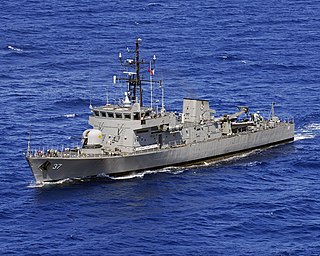
BRP Artemio Ricarte (PS-37) is third ship of the Jacinto-class corvettes currently assigned to the Offshore Combat Force of the Philippine Fleet. She is one of few ships in the Philippine Navy equipped with modern systems after the completion of combat, navigation and weapon systems upgrade of her class in August 2019. She was originally called HMS Starling (P241) during her service with the Royal Navy.

The BRP Apolinario Mabini (PS-36) is the second ship of the Jacinto-class corvettes currently assigned to the Offshore Combat Force of the Philippine Fleet. She is one of few ships in the Philippine Navy equipped with modern systems after the completion of combat, navigation and weapon systems upgrade of her class in August 2019. She is named after Apolinario Mabini, a hero of the Philippine revolution and a former prime minister. She was originally called HMS Plover (P240) during her service with the Royal Navy.
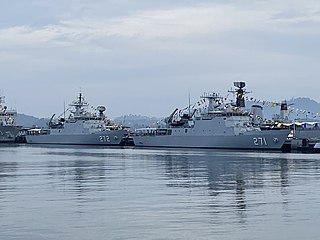
The Gagah Samudera is a class of training ships of the Royal Malaysian Navy (RMN). The two ships were built jointly by Malaysia and South Korea under a shared development programme, with one ship built in South Korea and the other in Malaysia, The ships, named KD Gagah Samudera and KD Teguh Samudera are currently in service with Royal Malaysian Navy. All RMN ships carry the prefix KD

The Esmeraldas-class corvettes are a class of corvette in service with the Ecuadorian Navy, built in Italy by Fincantieri, entering service in the early 1980s.

KD Kasturi is the lead ship of Kasturi-class corvette of the Royal Malaysian Navy (RMN). She were acquired in the 1980s and served under 22nd Corvette Squadron of RMN and based in Lumut Perak. Kasturi is based on HDW's FS 1500 design.

KD Laksamana Hang Nadim (F134) is the lead ship of Laksamana-class corvette currently in service with the Royal Malaysian Navy. She are currently serving in the 24th corvette Squadron of the Royal Malaysian Navy. She is based on the Fincantieri Type 550 corvette design.

KD Laksamana Tun Abdul Jamil (F135) is the second ship of Laksamana-class corvette currently in service with the Royal Malaysian Navy. She built by Fincantieri based on the Type 550 corvette design. Laksamana Tun Abdul Jamil constitute the Royal Malaysian Navy's 24th corvette Squadron.
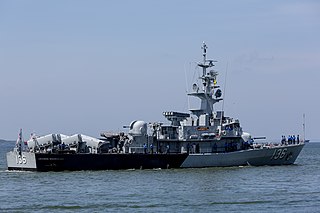
KD Laksamana Muhammad Amin (F136) is the third ship of Laksamana-class corvette currently in service with the Royal Malaysian Navy. She built by Fincantieri based on the Type 550 corvette design and currently serving in the 24th corvette Squadron of the Royal Malaysian Navy.

KD Laksamana Tan Pusmah (F137) is the fourth Laksamana-class corvette currently in service with the 24th corvette Squadron of the Royal Malaysian Navy. She built by Italian company Fincantieri based on the Type 550 corvette design.
